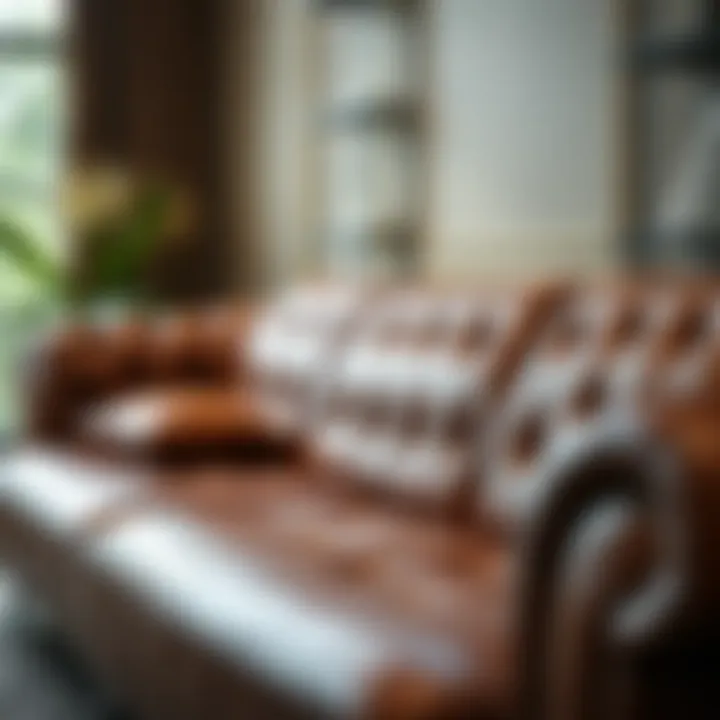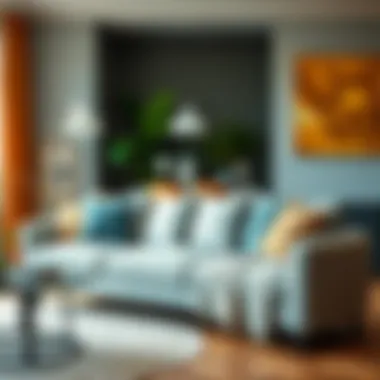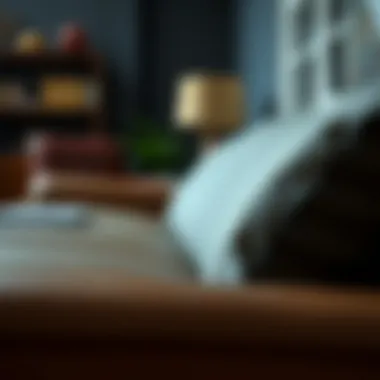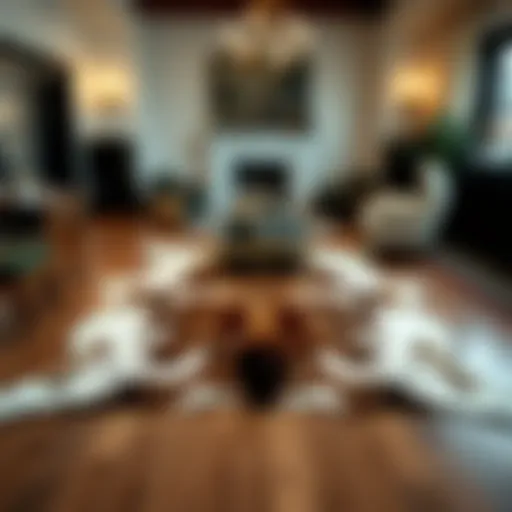Leather vs. Fabric Sofas: Key Insights and Tips


Intro
In the world of home furnishings, the sofa often serves as the centerpiece around which the rest of a living room is crafted. When it comes to choosing between leather and fabric sofas, the decision can weigh heavily on the minds of homeowners, designers, and anyone looking to spruce up their living space. Each material carries its own unique set of features, styles, and maintenance requirements that can have a significant impact on both aesthetics and functionality.
This guide seeks to cut through the noise, presenting a thorough examination of leather and fabric sofas. We'll delve into everything from the characteristics that set these options apart to practical tips for selection and care. Whether you are a seasoned designer or simply someone looking to furnish your first home, understanding these differences is crucial for making a well-informed choice.
Picture yourself settled into your new sofa with a cup of coffee in hand, appreciating the thoughtfulness that went into your selection. The journey to that moment starts with understanding the intricate details of materials, styles, and trends.
Let’s roll up our sleeves and dive into the heart of furniture styles and trends.
Foreword to Sofa Materials
When it comes to furnishing a home, the choice of sofa is pivotal. Sofas serve as the centerpiece of living spaces, offering both functional seating and aesthetic value. Understanding the difference between leather and fabric sofas is crucial for homeowners, designers, and anyone who seeks to create a space that reflects personal style and comfort.
The materials used in sofa production can significantly influence not just their look, but also their comfort, longevity, and ease of maintenance. This section sets the stage for a comprehensive exploration into these two dominant sofa categories, each with its unique traits and appeals.
Definition of Leather Sofas
Leather sofas are crafted from animal hides, which typically undergo a rigorous tanning process to ensure durability and aesthetic appeal. The result is a material that embodies luxury and sophistication. The tactile experience of leather is distinct—its smooth surface often feels cool to the touch, which can be particularly refreshing in warm climates.
In today’s market, leather sofas come in various types, including full-grain and top-grain leather, each varying in quality and cost. Commonly seen in high-end galleries or car showrooms, leather sofas offer a sense of elegance and refinement, turning any living space into a luxurious retreat. They're often favored by those who prioritize timeless style and are willing to invest in quality furnishings.
Definition of Fabric Sofas
Fabric sofas, on the other hand, comprise a wide variety of materials, ranging from cotton and linen to synthetic blends. This broad spectrum affords considerable flexibility in terms of colors, patterns, and textures, allowing homeowners to express personal style more vibrantly. Fabric sofas are generally seen as more casual and can lend a cozy atmosphere to a living area.
Moreover, the diverse selection of fabric options includes treatments designed for stain resistance—great for families with young children or pets. Fabric sofas often boast a more approachable price point, making them accessible for various budgets. They provide comfort with warmth and can be easily customized with cushions and throws, leading to a fresh and unique aesthetic tailored to individual tastes.
"Choosing between leather and fabric is not just about material; it's about defining the soul of your space."
Understanding these definitions anchors the following discussions about the historical significance, pros and cons, and practical considerations for each type of sofa, ensuring readers can make informed choices that align with their lifestyle and design vision.
Historical Context of Sofa Materials
Understanding the historical context of sofa materials, namely leather and fabric, opens up a treasure chest of insight for homeowners, designers, and retailers alike. It provides a lens through which we can view the evolution of interior design choices, influenced by both social trends and technological advancements. This backdrop adds a layer of depth to the decision-making process when choosing a sofa, offering not just a piece of furniture but a part of human culture and craftsmanship.
Leather: A Timeless Choice
Leather has been a sign of elegance for centuries. Its appeal dates back to ancient civilizations where animal hides were utilized not just for clothing but also for furnishings. The durability and unique allure of leather have solidified its status as a luxury material. Historians note that in the 18th century, leather began to appear in the homes of nobility across Europe, being valued for its sophisticated look and long-lasting nature.
Key Elements of Leather's Appeal
Leather isn’t just about good looks; it’s a robust option that withstands the test of time. Here are some significant factors that contribute to its enduring charm:
- Historical Value: Leather tells a story, echoing the craftsmanship of artisans through various eras. This rich history resonates with many homeowners looking to add character and culture to their spaces.
- Luxury and Prestige: Owning a leather sofa can often feel like a status symbol. Its smooth finish and rich texture convey a sense of luxury that few materials can match.
- Sustainability Considerations: In recent times, there's a growing emphasis on sustainable sourcing of leather, reflecting a shift in how consumers view their purchase choices. It’s beneficial to note that leather, when cared for properly, can significantly outlast synthetic alternatives, leading to less waste in landfills.
“Leather is not just an aesthetic choice; it’s a testament to the craftsmanship that spans millennia.”
Fabric Trends Through the Decades
In contrast, fabric sofas have made noticeable waves through changing trends, reflecting societal shifts and technological progress. From the extravagant patterns of the roaring twenties to today’s minimalist tones, fabric upholstery has morphed with the times.
Fascinating Fabric Transitions
- 1920s - The Art Deco Influence: This era saw a flourish in bold fabrics like velvet and silk, often featuring geometric designs that mirrored the architecture of the time. Sofas became canvases for artistic expression.
- 1950s - The Age of Vinyl: As healthcare improved, the introduction of synthetic materials gained traction. Vinyl was hailed for its ease of clean-up and maintenance, making it a preferred choice for families.
- 1970s and Beyond - Patterns and Textures: Fabric utilization saw a boom, showcasing whimsical designs and vibrant colors, a reflection of the cultural revolutions occurring.
- Modern Era - Eco-Friendly Fabrics: Today, many consumers lean towards sustainable options, often made from recycled plastics or organic fibers. These modern fabrics offer not just comfort, but also peace of mind for the environmentally conscious.
Fabric has found its place not merely as a functional choice but as a reflection of personal style and values.
Summary of Fabric Trends
Here’s a quick look at how fabric trends have evolved:
- 1920s: Ornate designs, rich textures.
- 1950s: Introduction of vinyl for ease of maintenance.
- 1970s - Present: Colorful and sustainable fabrics reflecting modern values.
By exploring these rich historical narratives of leather and fabric, we gain essential context that influences today's decision-making for future sofa purchases.
Advantages of Leather Sofas
When it comes to selecting furniture, leather sofas often come to mind as a prestigious option. They are viewed as symbols of luxury and elegance in various home settings. But what lies beneath this reputation? Understanding the distinct advantages of leather sofas can help homeowners and design enthusiasts appreciate their value better.
Durability and Longevity
Leather sofas are known for their durability and longevity. Unlike fabric, leather can withstand the test of time if properly cared for. It tends to age gracefully; in fact, many people appreciate the unique wear patterns that develop over time.
In a busy household, this can be a major plus. Families with kids or pets often find that leather holds up better against spills and scuffs compared to most fabrics. With minimal effort, an occasional wipe down with a damp cloth can suffice for everyday cleaning, ensuring that your sofa maintains its sleek look.
"When choosing furniture, consider investments that stand the test of time. Leather is often a prime contender due to its resistance to wear and tear."
Maintenance and Care
While some may perceive leather as high-maintenance, the reality is that caring for a leather sofa can be quite straightforward. A simple routine of cleaning and conditioning can extend its life well beyond that of fabric sofas. Conditioning the leather keeps it supple and prevents cracking. Most leather-specific products are user-friendly and easy to apply, making the maintenance process less daunting.
However, one does need to steer clear of harsh chemicals that can damage the material. It's also prudent to keep the sofa out of direct sunlight, as UV rays can precipitate fading over time. Regular attention to maintenance ensures that the sofa retains its aesthetic appeal.
Sophisticated Aesthetic Appeal
One cannot ignore the aesthetic appeal of leather sofas; they often exude a sense of sophistication that simply cannot be replicated. Leather's sleek texture and rich color options can transform a space, bringing a touch of elegance to both modern and traditional interiors. It complements various styles, whether you have a minimalist approach or a more eclectic taste.
Furthermore, leather sofas are available in a myriad of designs—from streamlined styles to plush, overstuffed options. This variety ensures that homeowners can find a piece that not only fits their taste but also enhances their home decor. The timeless nature of leather means that it often remains fashionable through changing trends, making it a wise choice for those who wish to invest in quality furniture.


In summary, the advantages of leather sofas encompass durability, straightforward maintenance, and a sophisticated appeal that sets them apart in any space. By recognizing these benefits, potential buyers can make informed choices that align with both functionality and style.
Disadvantages of Leather Sofas
When diving into the world of sofas, it's essential to weigh both the pros and cons of any material you are considering. Leather, often admired for its luxurious feel and sophisticated look, does come with a set of disadvantages that potential buyers should not overlook. Understanding these aspects is key to making a sound decision that aligns with your lifestyle and preferences.
Higher Price Point
One of the most glaring drawbacks of leather sofas is the price tag. Compared to fabric options, leather tends to be on the higher end of the pricing spectrum. This can be a dealbreaker for many shoppers looking for cost-effective choices without sacrificing style. For instance, genuine leather can turn heads, but it also requires a deeper wallet.
Consider the following when evaluating the costs:
- Initial investment: Leather sofas may cost two to three times more than their fabric counterparts.
- Longevity: While the upfront cost is steep, many view leather as an investment due to its durability and lifespan. Yet, this does not always translate to immediate affordability.
Many homeowners attempt to cut costs by opting for synthetic leather, which can have a significantly lower price but often fails to deliver the same level of quality and comfort. Ultimately, the initial costs can lead to buyer's remorse if the purchasing choice does not sit well with one's financial situation.
Temperature Sensitivity
Another aspect worth considering is how leather responds to temperature changes. Leather can be a bit finicky, especially in extreme conditions. During warmer months, leather tends to heat up, making it feel sticky and uncomfortable to sit on. Conversely, when it’s cooler, leather can turn chilly, giving you that unwelcome shiver upon sitting down.
This sensitivity can present challenges in terms of:
- Seasonal discomfort: In areas with fluctuating temperatures, leather may not provide the cozy experience one seeks in a sofa, pushing buyers towards fabric options that are more temperature-tolerant.
- Airflow: Genuine leather has a particular structure that limits airflow, causing discomfort when lounging for long periods.
Potential for Scratches and Damage
Though leather is robust, it isn’t infallible. One of the major worries is its susceptibility to scratches and potential scuffs. The shiny, polished look can be easily marred by sharp objects or even pets with claws. It’s vital to think about how the sofa will be used, especially if you have children or pets running around.
Important points to ponder include:
- Surface damage: Unlike fabric, which can often hide stains or minor tears, scratches on leather are glaringly obvious and can detract from its aesthetic.
- Repair costs: While minor repairs are an option, they can be costly and necessitate specialized cleaning products, which might put a dent in your budget further down the line.
Advantages of Fabric Sofas
Fabric sofas have carved a significant niche in the furniture landscape, and rightly so. They offer a range of benefits that often present them as a more attractive option compared to their leather counterparts. From aesthetic appeal to practical considerations, choosing fabric can be a reflective choice molded by lifestyle needs and design preferences.
Variety in Styles and Textures
One of the most compelling advantages of fabric sofas lies in their diverse styles and textures. Homeowners today are met with an endless array of fabric options, allowing them to curate a living space that reflects their unique taste. Whether it is cozy cotton, sleek linen, or plush velvet, each material presents its own charm.
Textures add tactile appeal and visual interest, allowing homeowners to mix and match with other elements in their homes. For instance, a plush microfiber sofa can create an inviting atmosphere in a family room, while a contemporary geometric pattern might elevate a minimalist setting. The choices are nearly infinite; you can find fabrics in every conceivable color, pattern, and weave.
This versatility in design not only caters to personal aesthetics but also enables a smoother integration into various interior design schemes. Rustic, modern, bohemian, or eclectic, fabric sofas can seamlessly fit into any style you desire.
Affordability and Accessibility
Price often plays a pivotal role in the selection process of a sofa. Compared to leather, fabric sofas generally come with a friendlier price tag. This affordability opens doors for many homeowners who might be on a tighter budget yet still wish to experience quality seating. Fabric options allow consumers to get more bang for their buck without compromising style.
Especially in a world where trends shift faster than a sneeze, having reasonable access to stylish fabric sofas is key. When you fancy a change or just wish to refresh your space, it's far less daunting to consider a fabric sofa than leather. This accessibility extends beyond initial purchase; many fabric sofas are more straightforward to upcycle or reupholster later on, providing a sustainable choice for the eco-conscious homeowner.
Comfort and Warmth
Another reason why fabric sofas have prominent standing is due to their undeniable comfort and warmth. Unlike leather, which can sometimes feel cold or rigid, fabric sofas generally offer a more inviting experience. They tend to retain heat better, making them cozy spots during chilly evenings. This warm touch often makes fabric a preferred choice for family spaces where comfort is paramount.
Moreover, the softness of many fabric types allows for a relaxing seating experience. You can snuggle into a cushy fabric sofa for hours without feeling the stiffness that some leather options may impart. Furthermore, fabric supports casual lounging, ideal for family game nights or cozy movie marathons with friends.
Choosing a fabric sofa not only lends style to your home but also envelops you in comfort, making it a practical choice for everyday living.
In summary, the advantages of fabric sofas - from their variety in styles and textures to their affordability and warmth - showcase why they remain a popular choice for many households. By understanding these benefits, homeowners can better appreciate what fabric sofas bring to the table, allowing for more informed and thoughtful decision-making.
Disadvantages of Fabric Sofas
While fabric sofas offer a plethora of styles, colors, and textures, they come with their own set of drawbacks that any potential buyer must consider. It is crucial to weigh these disadvantages against the benefits to make an informed decision. This section highlights the primary challenges associated with fabric sofas, particularly focusing on maintenance and longevity, both of which can significantly impact your satisfaction with the purchase.
Stains and Maintenance Challenges
One of the most glaring issues with fabric sofas is their susceptibility to stains. Unlike leather, which can often be wiped down, fabric can absorb spills much quicker, leading to unsightly marks that may become permanent if left untreated.
- Types of stains: Common culprits include food spills, pet accidents, and even sweat, which can become troublesome if not addressed promptly.
- Cleaning challenges: Many fabric materials require specific cleaning methods. For instance, some may be machine washable while others demand delicate handling, making it tricky to maintain their appearance flawlessly over time. Additionally, even with the right cleaning products, there's always a risk of color fading or fabric damage.
Homeowners often find themselves purchasing stain-resistant sprays or specialized cleaners, but these can add up over time, leading to ongoing maintenance costs. Moreover, the fabric may still become dingy even with regular upkeep, necessitating deep cleaning or professional services, which can be rather inconvenient.
Shorter Lifespan Compared to Leather
When it comes to durability, fabric sofas typically have a shorter lifespan than their leather counterparts. While you might initially save some cash by opting for a fabric sofa, you might end up needing to replace it sooner than anticipated.
- Wear and tear: Fabric can wear out more quickly, especially in high-traffic areas. The material might fray, lose its shape, or develop a worn appearance that detracts from the overall aesthetic of your home.
- Less resilient: Fabric is less resilient compared to leather, which naturally develops a patina and can withstand the test of time if cared for properly. For many, this might ultimately lead to purchasing yet another sofa before they truly want to.
Overall, these disadvantages highlight the need for thorough consideration when selecting a fabric sofa. While they can offer immediate satisfaction in terms of style and comfort, the potential for high maintenance and a shorter lifespan is something worth contemplating before making a commitment.
Key Factors to Consider When Choosing a Sofa
Choosing the right sofa can be a bit daunting, but understanding some key factors can take the guesswork out of the equation. A sofa isn’t just a piece of furniture; it’s often the heart of the living space where families gather, entertain guests, and spend leisurely hours. Therefore, consideration of various elements is crucial to ensure the ideal match for your needs.
Usage and Purpose
The usage and purpose of your sofa are paramount. How do you envision using it? If it's for entertaining, a larger sectional might fit the bill. Conversely, if you have a cozy reading nook in mind, a loveseat could be perfect. Think about the everyday activities that will occur around your sofa. Will children be playing on it, or will it serve as a sanctuary for relaxation? Also, consider the type of use: light use might allow for softer fabrics, while heavy-duty usage calls for more durable materials, like leather.
Assess your lifestyle as it directly impacts this decision. If your sofa gets a lot of wear and tear from family activities, look for options that can withstand some rough treatment without showing signs of wear too quickly.


Lifestyle and Pet Considerations
If you share your home with pets, this factor weighs heavily on your selection process. Pick something that can withstand the occasional scratch or spill. Fabric sofas can harbor pet fur and odors, requiring a bit more maintenance. On the other hand, leather tends to repel hair and can be wiped down easily. But remember, certain leather types are more prone to scratches and can require an extra layer of care. Additionally, think about the color; darker tones can mask stains better than lighter shades.
Paw-friendly textiles should be on your radar too. Look for options that are specifically designed to repel stains or easily cleanable. Investing in furniture made from durable materials may save you from future headaches of cleaning up after furry friends.
Interior Design Themes
The sofa is likely the most significant piece in your living area, so its style needs to align with your overall interior design theme. Traditional homes might favor classic leather options, while modern spaces may shine with vibrant fabric choices. It’s essential to consider not just the fabric or leather finish, but also the sofa’s silhouette. Is there a contemporary chesterfield you fancy, or perhaps a minimalist Scandinavian couch? Whatever your taste, ensure that it corresponds with existing decor.
Taking your wall colors, flooring, and overall room aesthetics into account can be a game-changer. Textures play a vital role too. Mixing leather with softer textiles can add depth and interest to a space, while monochromatic themes can instill a sense of calm.
"A well-chosen sofa enhances a room's aesthetic and overall comfort, making it a delight to be in and reflect the homeowner's style."
Comparative Analysis: Leather vs. Fabric
When it comes to choosing the right sofa for your home, understanding the nuances between leather and fabric options can greatly influence your decision. This comparative analysis dives into three pivotal aspects: cost, comfort, and maintenance needs. Whether you're furnishing a cozy apartment or a spacious family room, grasping these factors ensures that you make a suitable choice that aligns with your preferences and lifestyle.
Cost Analysis
In the realm of furniture, cost often dictates the decisions homeowners make. Leather sofas tend to carry a higher price tag compared to their fabric counterparts. While this can be attributed to the materials used and the craftsmanship involved in their creation, it's essential to look beyond initial expenses.
- Leather Sofas: Generally, they represent an investment. High-quality leather options can last for years, sometimes decades, without losing their allure. The upfront cost may sting, but the longevity can balance the equation in the long run.
- Fabric Sofas: They offer an affordable entry point, making them accessible for more budgets. However, their lifespan is often shorter than that of leather, which could mean a replacement sooner than expected.
In essence, the initial purchase price of a sofa should be weighed against its durability and potential replacement costs.
Comfort Levels
Comfort is where the battle between leather and fabric sofas gains a poignant narrative. Here, personal preference plays a significant role, but some general observations can be made.
- Leather Sofas: They often lend an air of sleekness and sophistication. While they can feel cool to the touch at first, many people find that leather warms to the body as it becomes used. However, some individuals might find leather less breathable than fabric, especially during warmer seasons.
- Fabric Sofas: These sofas can be enticingly plush and cozy, inviting relaxation. Their softer surfaces and variety of materials contribute to a more breathable experience, making them ideal for long lounging sessions. The textures available—ranging from velvets to cotton blends—can make a noticeable difference in comfort.
Ultimately, a test sit can be the best judge, as personal touch and feel vary vastly between individuals.
Maintenance Needs
Maintenance is another crucial dimension where leather and fabric diverge. Understanding the care requirements for each can save time, money, and headaches down the line.
- Leather Sofas: While they are known for their durability, they do require specific upkeep. Regular cleaning with appropriate products prevents dust buildup and keeps the material supple. Additionally, conditioning is essential to maintain their aesthetic appeal and prevent cracking over time.
- Fabric Sofas: On the flip side, they can be prone to stains and may require more frequent cleaning. Many fabrics can withstand vacuuming and spot treatment, but depending on the material, some stains might set in more stubbornly than others. Choosing a fabric with stain resistance can be a smart move if maintenance is a concern.
At the end of the day, assessing your lifestyle—whether you have kids or pets—plays a significant role in determining which type of sofa will suit your maintenance regime best.
For further reading, refer to resources like Wikipedia and Britannica on the dynamics of sofa materials.
Care and Maintenance for Leather Sofas
Maintaining leather sofas is essential to ensure their longevity and appearance. Leather, while durable, can be prone to damage if not given proper care. Understanding the techniques for cleaning and conditioning, and the importance of protection, are crucial aspects that can greatly impact the lifespan of your investment.
Cleaning Techniques
Cleaning your leather sofa isn't like tossing a fabric couch into the washing machine. Leather requires a gentle touch. For everyday dust and dirt, a soft cloth or microfiber duster can do wonders. But when it comes to deeper cleans, here’s what to consider:
- Use a specialized leather cleaner: It's formulated specifically for leather, avoiding harsh chemicals that might strip oils.
- Spot Test First: Always try a small, hidden area first to ensure the cleaner won't cause discoloration.
- Gentle Ingredients: Consider using a mix of water and mild soap if you're looking for a DIY solution. Do not soak the leather; dampen the cloth instead.
- Drying: After cleaning, a soft, dry cloth should be used to remove excess moisture and prevent water stains.
"A little care goes a long way; don't wait until your leather looks worn to take action."
Keeping any spills or stains at bay requires immediate attention. For instance, milk or wine can leave marks if left unattended. Simply blot the area with a clean cloth; don’t rub, as this can worsen the stain.
Conditioning and Protection
Conditioning is akin to moisturizing your leather sofa, keeping it supple and preventing cracking. This step is often overlooked but is vital in preserving the aesthetic and functional qualities of leather. Here’s how to approach this:
- Frequency: Conditioning should generally be done every 6 to 12 months, depending on usage and climate. Dry air can cause leather to lose its natural oils more quickly.
- Choose a Quality Conditioner: A good leather conditioner doesn’t just nourish the sofa but can also provide a protective barrier against stains and fading.
- Application: Apply the conditioner with a clean cloth in small sections, giving it time to absorb. Be cautious not to over-saturate.
In addition to conditioning, there are protective measures that can enhance your leather sofa’s durability:
- Consider a leather protectant: This forms a barrier against stains and spills, making future cleaning easier.
- Avoid direct sunlight: Positioning your sofa away from direct sunlight can prevent fading and keep the leather looking fresh.
- Temperature and Humidity Control: Keeping your home at stable humidity levels will help prevent leather from drying out or becoming too damp.
Care and Maintenance for Fabric Sofas
Maintaining fabric sofas is key to prolonging their lifespan and keeping them in tip-top shape. Unlike leather, which requires a specific kind of care, fabric furniture needs quite a bit of attention to keep it looking fresh and inviting. This section will dive into techniques that are not just helpful but absolutely essential for homeowners who want to preserve their investment. Understanding the nuances of fabric care can save time, money, and reduce the headache of unexpected damage.
Fabric-Specific Cleaning Methods
When it comes to cleaning fabric sofas, different textiles call for unique approaches. Generally, a good rule of thumb is to check the manufacturer's tag for specific cleaning instructions. However, some common fabric types can be cared for as follows:
- Microfiber: This one is a gem! Clean it with a damp cloth and a bit of mild detergent; it's resistant to stains and easy to maintain.
- Cotton: Washable cotton covers can be tossed directly into the washing machine, but spot cleaning works well for less stubborn stains.
- Velvet: A bit more delicate, velvet requires a gentle approach—using a soft brush to lift dirt, and cleaning with specialized velvet cleaners is often recommended.
- Synthetic Blends: Check if it’s safe to use water or a solvent-based cleaner, as some materials might react differently.
A good practice is to vacuum the sofa regularly to keep dust and crumbs at bay. Focusing on the crevices, where debris loves to hide, keeps your seating area looking sharp.
Stain Removal Techniques
Stains are the nemesis of any fabric sofa, and quick action is crucial. Here are some tried and true techniques to tackle stains before they become a permanent fixture on your beloved couch:
- Water-based stains (like juice or coffee): Blot the area promptly with a clean cloth soaked in lukewarm water. Avoid rubbing, as this may spread the stain.
- Grease stains: Sprinkle some cornstarch on the area and let it sit for about 30 minutes. This will absorb the grease, making removal easier. Afterward, vacuum the area gently.
- Ink stains: Dabbing gently with rubbing alcohol on a cotton ball can do wonders. Just ensure to test it in an inconspicuous spot to prevent discoloration.
- Pet stains: For those furry friends that sometimes misbehave, an enzymatic cleaner often works best to neutralize odors and eliminate stains.
Tip: Always blot, never rub. This helps prevent making the stain worse.
Regular maintenance tools like a lint roller or upholstery brush can aid in keeping the fabric fresh and looking sharp. Furthermore, considering fabric protectors can be beneficial, as they create a barrier against dirt and spills, allowing for easier cleaning. Remember, investing in proper care methods not only maintains your fabric sofa but also enhances your overall living space aesthetics.


In summary, taking the time to understand the specific needs of your fabric sofa is vital. From the right cleaning methods to smart stain management, these practices will ensure your sofa remains a comfortable yet stylish centerpiece in your home.
Trends in Sofa Designs: What to Expect
The landscape of sofa design is more dynamic than a Saturday night dance floor. It’s important to keep an eye on these trends because they reflect changing preferences and lifestyles, which can greatly influence your comfort and aesthetic satisfaction in your living space. Whether you’re a homeowner, designer, or DIY enthusiast, understanding these trends can help you make informed decisions and get the most bang for your buck.
Sustainability in Materials
Sustainability is no longer just a fad; it’s become a crucial element in sofa design. People are becoming more aware of the environmental impact of their purchasing decisions. This has led to a significant uptick in demand for sofas made from sustainable materials. Cedar, bamboo, and various recycled textiles are now showing up in furniture stores like a long-lost friend.
Using sustainable materials not only helps the environment but also adds a unique flair to your decor. Imagine a sofa that tells a story—crafted from reclaimed wood or eco-friendly fabrics—all while looking stylish. Homeowners and designers are increasingly opting for pieces that boast longevity and a smaller ecological footprint. The appeal goes beyond the green credentials; it taps into an emotional aspect, connecting individuals to the larger cause of sustainability, making their home feel more special.
Another factor worth mentioning is the certification of sustainable practices. Certifications like GREENGUARD and FSC (Forest Stewardship Council) help you choose products that have a lesser environmental impact. When you pick a sofa that’s marked with these labels, it’s like giving a thumbs-up to the planet.
Technological Innovations
As we dive deeper into the digital age, technology is filtering its way into sofa design as well. One exciting development is the integration of smart technology into upholstery. Imagine reclining on a sofa that adjusts to your preferred comfort level at the touch of a button or even through a smart device. These innovations are not just about opulence; they are improving user experience in practical ways.
Some sofas now come equipped with built-in charging stations and Bluetooth speakers, merging aesthetics with functionality. It’s like having a Swiss Army knife for your living space—everything you need, right where you want it.
Additionally, manufacturers are utilizing advanced materials that provide enhanced durability, making your investment last longer—even if three kids and a rambunctious dog are part of the equation. Fabrics that are water-resistant and stain-proof are becoming much more prevalent, which is an attractive feature for anyone looking to maintain a pristine home with minimal effort.
"Innovation in sofa design is where the cozy meets the cutting-edge, pushing boundaries in both functionality and aesthetics."
In summary, keeping tabs on these evolving trends in sofa design allows you to strike a balance between style and practicality. With sustainability efforts ramping up and smart technologies making their way into home furnishings, the options for stylish comfort are expanding. Each choice you make brings you one step closer to a living space that reflects your values and meets your needs.
Sofa Sizing and Layout Considerations
When it comes to choosing a sofa, sizing and layout are often overlooked yet pivotal aspects of the decision-making process. Understanding the dimensions of the space where the sofa will reside and how it interacts with the existing furniture is crucial. The right sofa can enhance the aesthetics and functionality of a room, while a poor choice can create visual clutter or make the space feel cramped. Here’s what to consider when determining the size and layout of your new sofa.
Measuring Your Space
Before making your purchase, one must take accurate measurements of the room where the sofa will be placed. Here's a practical approach to simplify the measuring process:
- Room Dimensions: Measure the length and width of the room, including noting any architectural features like windows and doors.
- Existing Furniture: Take into account the size and position of other furniture pieces. This includes coffee tables, chairs, or media cabinets, as they affect how the sofa will fit alongside them.
- Sofa Size: Sofas can vary significantly in size. Standard lengths typically range from around 72 inches to over 96 inches. Depth usually lands between 30 to 40 inches. Make sure to keep your measurements close at hand, as this will help avoid surprises when the sofa arrives.
It’s also wise to consider the height of the sofa in relation to other furnishings to ensure comfortable seating and proportions. "Measuring is a necessary step, but it can feel tedious. However, taking the time pays off when the sofa fits perfectly into your lifestyle and space."
Creating Functional Layouts
After measuring your space, the next step is to envision how the sofa will fit into the overall layout of the room. A functional layout balances aesthetics with practicality. Here are some guidelines to consider:
- Flow of Movement: Think about how people will move through the space. Ensure there are clear pathways that allow for easy traffic flow. Avoid placing the sofa in a way that blocks doorways or creates awkward navigational challenges.
- Zoning: Use the sofa to create zones within an open floor plan. For example, placing a sofa to delineate a living area from an adjoining dining space can increase functionality.
- Orientation: The direction the sofa faces can significantly impact the room's usability. If you love to watch TV, align the sofa so that it's directly facing the entertainment unit. If conversations are your goal, placing two sofas opposite one another can foster a more engaging environment.
- Complementing Design Elements: Consider how your sofa's color and design will integrate with the rest of your decor. A bold color can serve as a statement piece, while a neutral sofa allows for more flexibility in accent pieces.
In creating your layout, it might be beneficial to sketch it out or use design software, which can give a clearer visual representation of how the pieces will work together.
By focusing on size measurements and layout possibilities, homeowners can make informed decisions that lead to a well-designed, functional space. The endeavor might seem complex, yet a thoughtful approach renders a living space that embodies both comfort and style.
Ultimately, the goal is to create a harmonious balance in your room by considering both the size of the sofa and its layout — each choice contributes to the overall feel of your home.
The Role of Upholstery in Interior Design
Upholstery plays a pivotal role in the world of interior design. It’s not just about comfort, though that’s a significant factor; upholstery can dramatically shift the mood and aesthetic of a room. Leather and fabric each bring their unique flair, catering to different tastes and preferences that suit various home environments. For homeowners and designers alike, understanding upholstery's importance can guide better choices in creating cohesive spaces that reflect personality and lifestyle.
Incorporating the right upholstery involves considering several elements, such as textures, colors, and durability. Each of these factors influences how a space feels and functions. For instance, luxurious leather may evoke sophistication, while vibrant fabrics can foster a lively and inviting atmosphere.
Impact on Room Aesthetics
When it comes to aesthetics, upholstery is akin to the frosting on a cake. It’s what ties a room together, emphasizing design elements while setting the tone.
- Color Palette: The color of upholstery can either harmonize or contrast with existing decor. Choosing a sofa in deep burgundy, for example, may serve as a stunning focal point in an otherwise neutral room.
- Texture Play: Different textiles can add depth to a room. A smooth leather sofa can juxtapose against rough-hewn wooden accents, creating an engaging dynamic. Sofas upholstered in cozy fabric can soften the hard lines of contemporary furniture, lending a warm touch.
- Style Consistency: Upholstery choices can reinforce a theme. If a space leans towards a minimalist vibe, a sleek leather sofa can enhance that simplicity, maintaining clean lines and a streamlined look. Conversely, bohemian influences often thrive on richer, patterned fabrics that tell a story.
Ultimately, upholstery influences not just how a space looks, but how it feels. Striking the right balance can transform an ordinary room into a cohesive and inviting retreat.
Matching Upholstery with Decor
Finding the perfect match between upholstery and overall decor is an art that goes beyond mere color matching. It's about ensuring that every element of your space communicates well.
- Theme Compatibility: Whether you lean towards modern, rustic, or eclectic styles, select upholstery that enhances the intended aesthetic. For example, a vintage fabric can bring warmth to contemporary spaces, while a sleek leather might clash with overly ornate decor.
- Contrast and Harmony: Creating contrast can be just as powerful as maintaining harmony. A bold geometric fabric can energize a subdued room, while complementary colors can elevate the design’s sophistication. Knowing when to balance or contrast can make all the difference.
- Functionality and Comfort: Consider the daily use of the room when matching upholstery with decor. A high-traffic area might necessitate durable materials, while a seldom-used formal space may indulge in more delicate fabrics.
The synergy of upholstery and decor requires thoughtful consideration. Getting it right can lead to a beautifully flowing space where design elements coexist seamlessly, showcasing an aesthetic that's both intentional and appealing.
"Good design is a lot like clear thinking made visual." - Edward Tufte
Culmination: Making an Informed Choice
Choosing the right sofa plays a pivotal role in both functionality and atmosphere of your living space. It impacts not just the aesthetics but also usability and comfort. By understanding the specific characteristics of leather and fabric sofas, individuals can recognize what best suits their needs. This article outlined the essential features, advantages, disadvantages, and maintenance aspects of both types, allowing readers to weigh various factors before making a purchase.
In a home, the sofa often becomes the centerpiece of social interactions. It's where families gather, friends meet, and numerous memories are crafted. Thus, making an informed choice hinges on gathering knowledge about one’s own lifestyle needs, aesthetic preferences, and budgetary constraints. This understanding goes a long way in guiding one to select a sofa that not only enhances the room's appearance but also stands the test of time in terms of wear and tear.
"An informed sofa choice reflects both the style and sensibility of the homeowner."
Balancing Aesthetics and Practicality
When selecting the perfect sofa, finding a balance between aesthetics and practicality is crucial. A beautiful sofa can indeed elevate the look of any room, but if it cannot withstand daily use or meet other functional needs, it may become more of a headache than a pleasure. Leather sofas often offer a sophisticated look; their sheen can complement luxurious decor. However, they can also feel cold in winter and are typically higher in cost.
On the flip side, fabric sofas come in a myriad of styles and textures. They tend to be warmer and more inviting, blending well with multiple design themes. Yet, they can suffer from stains and require a particular approach for maintenance. Keeping one’s specific usage patterns in mind — such as the presence of kids or pets — becomes a deciding factor in achieving harmony between looks and usability.
Final Thoughts on Sofa Selection
When the dust settles on the choice of sofa, it truly comes down to personal preference and practical requirements. One must ask questions like: How much wear will the sofa endure? How important is the aesthetic in relation to comfort? These considerations will guide one through a decision that is both thoughtful and fulfilling. After all, a sofa is not merely a piece of furniture; it's an investment in your home and lifestyle.
In the end, no matter if leather or fabric catches your eye, the key lies in ensuring the choice aligns with your unique lifestyle. Take time to research, feel fabrics, and immerse yourself in the variety to find what truly fits your home. For more insights about furniture choices, visit Wikipedia, Reuters, or discuss with friends on platforms like Reddit.
Your sofa can reflect your taste, stand up to your daily life demands, and enhance your personal sanctuary — make a choice that resonates with your needs.







